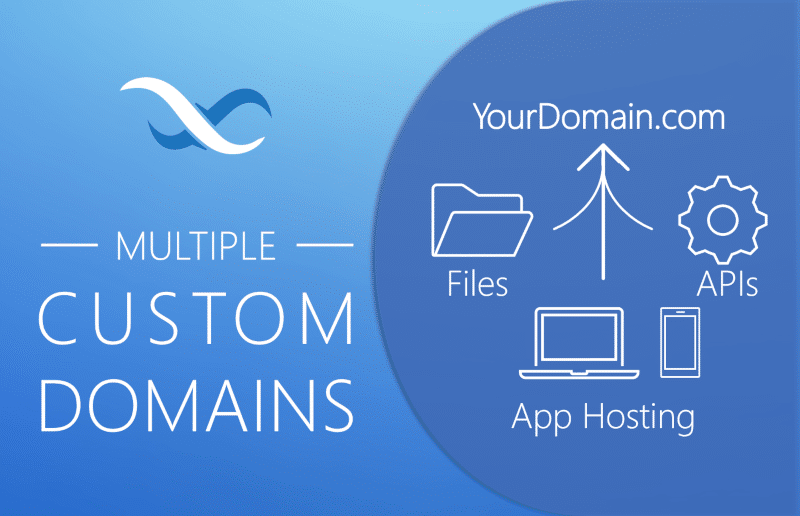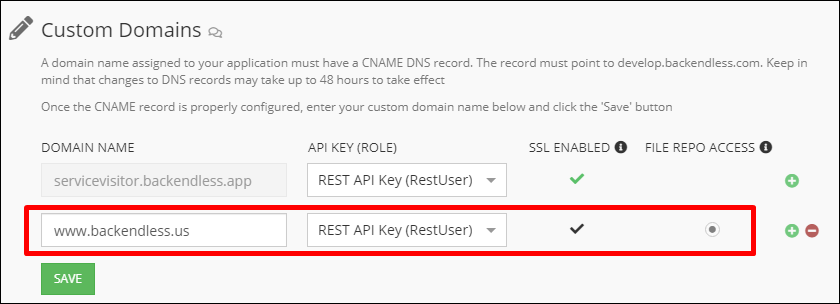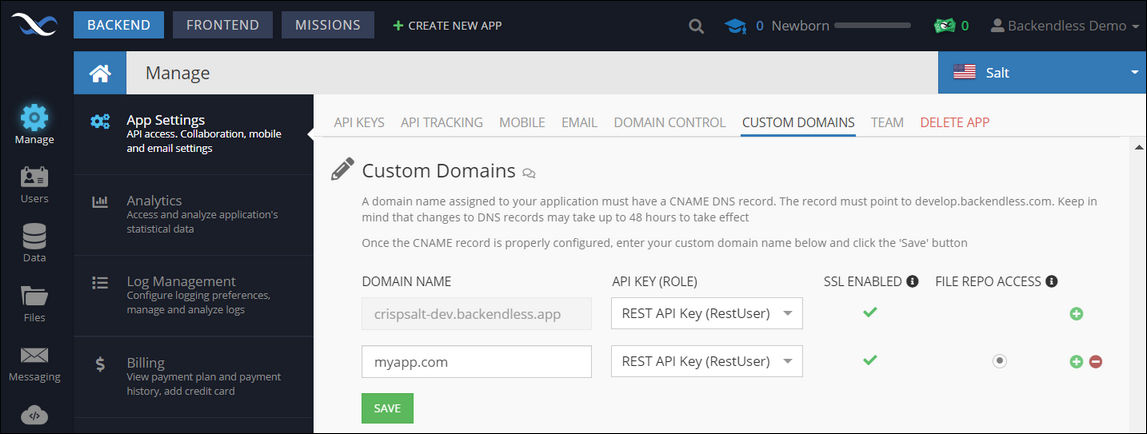Support For Multiple Custom Domains Per App

All Backendless apps have the ability to add a single custom domain for app hosting and API endpoints. Now, you may add additional custom domains to your application.
Upon creation, every new Backendless application is assigned a subdomain under the backendless.app domain. By default, this subdomain is the endpoint for all API operations.
You may also assign one or more custom domains for your Backendless app. Additionally, your custom domains may act as the endpoints for Backendless APIs and in the URLs for the files you upload in Backendless.
Manage Your Domains
To manage custom domains for your application, navigate to Manage > App Settings > Custom Domains.
In this section of Backendless, you can perform the following functions (right to left on the screenshot above):
- To add a domain, click the green “+” icon.
- To delete a domain, click the red “-” icon.
- When a domain has File Repo Access, Backendless Console will use the domain to generate URLs for the files uploaded to the file repository of your app. Those files are still stored within Backendless’ File Storage. To assign a custom domain to handle file repository access, click the corresponding radio button.
- Note that you cannot manually set your
backendless.appsubdomain for “File Repo access”. If you do not have a custom domain, or if you delete the custom domain with File Repo access, your repo access URL will default to yourbackendless.appsubdomain.
- Note that you cannot manually set your
- The SSL Enabled column indicates whether an SSL certificate for the domain has been deployed. To deploy a certificate for your domain, please contact support@backendless.com and we will generate a certificate for you. Custom SSL certificates are available with the Cloud 9 and Cloud 99 plans only.
- The API KEY (ROLE) is used to select an API Key/Role that will be used by Backendless when it processes requests arriving at the corresponding domain. Note that the selection of API Key/Role can include custom API keys.
API Calls To A Custom Domain
To use a custom domain for the API calls, the structure of the endpoint is:
http://your-custom-domain.com/api/
Let’s take a look at an example. Consider the following custom domain configuration:

To retrieve data from a table called City using that custom domain, you will use the following REST endpoint:
http://www.backendless.us/api/data/City
File Repo Access Via Custom Domain
Your custom domain can also be used to address files deployed in your application. The format of the file reference URL is:
http://your-custom-domain.com/api/files/path-to-folder/file.name
For instance, consider the following file. The application housing this file has the www.backendless.us domain configured:

Notice the filename is salad.jpg and it is located in the Root\pictures\Food directory. To access the file with custom domain, the URL is:
http://www.backendless.us/api/files/pictures/Food/salad.jpg
Before configuring a custom domain name in Backendless, make sure to:
- Create a CNAME record in the DNS for your custom domain name.
- Map the CNAME record to
develop.backendless.com(for the apps in the North American cluster)
eu-develop.backendless.com(for the apps in the European Union cluster) - Add your domain in Backendless console (Manage > App Settings > Custom Domains)
You can view the full documentation on Custom Domains here.
Multiple custom domain support is just one of the new features in this release. You can read our articles about the other new features released below:
Thanks for reading and Happy Codeless Coding!
